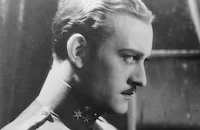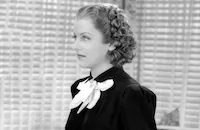Dangerous Corner

Brief Synopsis
Cast & Crew
Phil Rosen
Virginia Bruce
Conrad Nagel
Melvyn Douglas
Erin O'brien-moore
Ian Keith
Film Details
Technical Specs

Synopsis
When publisher Robert Chatfield discovers on his wedding anniversary that a valuable bond is missing from the company safe, suspicion is cast among the four partners: Robert, his brother Martin, his brother-in-law Gordon and Charles Stanton. That weekend, Charles calls on Martin and finds him dead from a bullet wound. After an exhaustive inquest, a jury declares Martin's death a suicide, and Robert and the others assume that guilt over the bond theft was the motive. Many months later, however, during an after-dinner discussion at Robert's country home, Robert begins to question his wife Freda and Ann, an assistant at the company, about the last time they saw Martin alive. Surprisingly, their answers differ significantly from their inquest statements, and curious to know what the women are hiding, Robert pursues his inquiries with vigor. Finally, Freda confesses that she had been in love with Martin, and Ann admits to her long-standing, unspoken adoration of Robert and her fear that he, not Martin, had stolen the bond. Although Robert is sympathetic to his wife's unfulfilled love, he denies the theft and demands that Charles, who had encouraged the rumor, explain himself. Charles casually admits to stealing the bond, which causes Robert to imply that Charles indirectly drove Martin to suicide because he believed that Robert was guilty. At this point, Ann confesses to having accidentally shot Martin herself, recounting a story of Martin's strange, drug-induced taunting and game-playing with a gun. Charles, who has loved Ann for years, then confesses that he knew all along about her participation in the crime, and Betty, Gordon's wife, states that not only is she miserable in her seemingly blissful marriage, but is suffering from an unrequited love for Charles, who reveals that he stole the bond to help her pay back a gambling debt. His romantic delusions about Betty shattered, Robert leaves the room and shoots himself. [Thus the first version of the story ends. In a second ending, which begins immediately after the first, the after-dinner conversation starts again, but this time, Charles proposes and is accepted by Ann, and Robert asks no questions, thus steering clear of the "dangerous corner."]

Director
Phil Rosen
Cast

Virginia Bruce

Conrad Nagel

Melvyn Douglas
Erin O'brien-moore

Ian Keith

Betty Furness

Henry Wadsworth

Doris Lloyd
Crew
Eugene Berton
Ralph Berton
John L. Cass
Anne Morrison Chapin
Perry Ferguson
B. P. Fineman
J. Roy Hunt
Archie Marshek
Van Nest Polglase
Madeleine Ruthven
Arthur Sircom
Max Steiner
Ivan Thomas

Film Details
Technical Specs

Articles
Dangerous Corner -
The storyline, which is almost impossible to summarize without revealing part of the narrative twist, involves a circle of friends who work together at a publishing company. Some members of the circle are married to each other: Robert Chatfield is married to Freda; her brother Gordon Whitehouse seems blissfully happy with his wife, Betty. Ann Beale, Charles Stanton, and Martin Chatfield (Robert's brother) are the single members of the group. The friends are about to celebrate Robert's birthday at the office when they notice that a bond is missing from the company safe. Only the men have keys to the safe, meaning Martin--the one member who is absent--must know what happened to the bond. A couple of days later, Charles arrives with bad news. Martin has committed suicide, leading the group to believe that he stole the bond in order to cash it in for personal gain.
A year passes, and the group gathers for dinner at the country home of the Chatfields. The guest of honor is author Maude Mockridge, whose mystery thrillers are successful releases for the publishing company. Robert steers the conversation in a philosophical direction, ruminating over the importance of revealing truth. Charles disagrees, taking the opposite opinion: "I think telling the truth is about as healthy as skidding around a corner at sixty." Ann's views are somewhere between the two extremes; she believes that half-truths are the best course of action. The discussion is a portent, setting up viewers for the revelations in the final third of the film.
When a tube burns out in the radio, Gordon, who is unable to find a replacement, jokes that now they will have to actually talk to each other. An unusual cigarette box reminds Ann of Martin, and the conversation turns to the last time each member of the group saw their friend alive. Stories conflict, lies unravel, and confessions unfold. By the end of the evening, the group is shattered by their unveiled truths, though that is not the end of their story.
Dangerous Corner was adapted from a successful play by J.B. Priestley, arguably the last sage of English literature, who wrote novels, plays, essays, radio monologues, and screenplays. This drawing room melodrama represented his first actual play, though an earlier novel had been adapted to the stage. Dangerous Corner got off to a slow start when it debuted in London in May 1932, but it soon became an enormous success, and it was performed all over the world. In October 1932, the play was staged at the Empire Theater in New York, where it was the outstanding success of the season.
Dangerous Corner is regarded as one of Priestley's "time plays," which also include Time and the Conways, I Have Been Here Before, and Johnson Over Jordan. Influenced by the theories of J.W. Dunne on time and recurrence, he adopted nonlinear narrative structures in which chronology is disrupted, events repeated, and time manipulated. A nonlinear structure is a narrative device associated with modern storytelling, making Priestley's time plays interesting to contemporary scholars. Audiences at the time, however, found them exciting and entertaining because of the surprises and plot twists.
The film version of Dangerous Corner differs from the play because there is more than one setting, which opens the story up to a small degree. Charles's attraction to Ann is introduced early in the film in Ann's apartment, and the discovery of the stolen bond occurs in the publishing offices before the heart of the story unfolds in the Chatfields' drawing room. In the play, Martin's death is backstory, while it unfolds in present time in the film. Also, changes were made in the script to accommodate the Production Code. In the play, Gordon's character is bisexual and reveals his love for Martin, the women openly confess to adultery, and Martin is addicted to drugs. Gordon's problems in the film are vague and indeterminate; Martin is colorful but not addicted to drugs, while the women admit to inappropriate feelings but no illicit behavior.
Despite these differences, much of the dialogue remains intact from the play, and it is the dialogue that is the driving force behind the narrative. The precisely composed dialogue serves the narrative in more ways than one. Characters reveal their darkest secrets and inner thoughts, which changes the viewers' perception of them. Amiable and convivial, Charles Stanton jokes and flirts with an ease and charm, but when his secret is revealed, he expresses a long pent-up bitterness. It seems Charles lacks the social status of the others. He started at the publishing company as a clerk and worked his way up, unlike Robert and Gordon who fell into their positions through family connections. They have never carried the same workload as Charles. When Robert and Gordon turn on him after they learn his secret, he unleashes an embittered tirade, surprising the audience with his resentment and hardness.
The dialogue also exposes hidden parts of the backstory necessary to unearth the actual cause of Martin's death. The truth unravels as one character admits his or her last interaction with poor Martin, which compels the next character to pick up the thread and spin the story in a different direction. When Ann sees a cigarette box, she is reminded that Martin had just received one like it, suggesting that she was the last to see him alive. In response to Ann, Freda trips herself up on a remark: She exposes that she gave the cigarette box to Martin, which places her on the hook that Ann just vacated. One character's admission becomes the narrative path that the next character must follow. Patient viewers who recognize the deftness of writing will understand that this is the key to drawing room melodramas, mysteries, or even comedies.
A dialogue-driven narrative is dependent on its actors. Of the cast members in Dangerous Corner, Melvyn Douglas, who plays Charles, was most adept at delivering long passages with fluidity and flair. Douglas had been acting in Hollywood for three years, costarring in everything from Counsellor at Law (1933), opposite John Barrymore, to James Whale's The Old Dark House (1932), based on a J.B. Priestley novel. He was in the process of establishing his star image as the affable, charming rogue, which would bring him stardom in romantic and screwball comedies by the end of the decade. More established stars Conrad Nagel and Virginia Bruce, who costarred as Robert Chatfield and Ann Beale, lack Douglas's charisma and energy. Depression-era actress Betty Furness, who later became a consumer activist, is noticeable as sweet-natured Betty, who seems to be in the perfect marriage with Gordon.
While contemporary audiences might balk at the amount of conversation, discussion, and argument in drawing room narratives, Dangerous Corner reveals Priestley's talent as a dramatist and Douglas's skill as an actor.
By Susan Doll
Producer: B.P. Fineman for RKO
Director: Phil Rosen
Screenplay: Anne Morrison Chapin and Madeleine Ruthven from the play by J.B. Priestley
Cinematography: J. Roy Hunt
Art Directors: Van Nest Polglase and Perry Ferguson
Editor: Archie Marshek
Musical Director: Max Steiner
Cast: Charles Stanton (Melvyn Douglas), Ann Beale (Virginia Bruce), Robert Chatfield (Conrad Nagel), Freda Chatfield (Erin O'Brien-Moore), Martin Chatfield (Ian Keith), Betty (Betty Furness), Gordon Whitehouse (Henry Wadsworth), Maude Mockridge (Doris Lloyd)

Dangerous Corner -
Quotes
Trivia
Notes
A pre-release Daily Variety review gives the running time as 83 minutes, suggesting that the film was cut significantly before its general release. RKO borrowed Virginia Bruce from M-G-M for this production. According to modern sources, studio publicity writers found advertising the film difficult because they were unable to emphasize the unusual double ending without compromising the surprise element at the same time. In the scene between "Ann" and "Martin," Martin drinks what appears to be a drug-laced cocktail, but the film makes no specific reference to the illicit substance.














